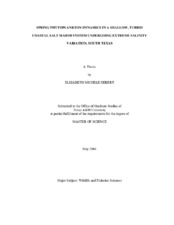Spring phytoplankton dynamics in a shallow, turbid coastal salt marsh system undergoing extreme salinity variation, South Texas
Abstract
The contribution of phytoplankton productivity to higher trophic levels in salt marshes is not well understood. My study furthers our understanding of possible mechanisms controlling phytoplankton productivity, abundance, and community composition in salt marshes. Across three consecutive springs (2001 to 2003), I sampled the upper Nueces Delta in south Texas, a shallow, turbid, salt marsh system stressed by low freshwater inflow and wide ranging salinity (<15 to >300 ppt). Water column productivity and respiration were estimated using a light-dark bottle technique, and phytoplankton biovolume and community composition were determined using inverted light microscopy. To determine their effect on the phytoplankton community, zooplankton and bacterioplankton abundance and several physical parameters were also assessed. Meaningful relationships among the numerous variables evaluated in this study were identified using principal component analysis (PCA). Despite high turbidity, phytoplankton productivity and biovolume were substantial. Resuspension appeared to play a major role in phytoplankton dynamics, as indicated by a positive relationship between ash weight and biovolume that explained up to 46% of the variation in the PCA. Negative relationships between zooplankton grazers and pennate diatoms of optimal sizes for these grazers suggested a functional grazing food chain in this system. Salinity also may have been important in phytoplankton dynamics, whereas nutrients appeared to play a minor role. Salinity increases may have been responsible for a decoupling observed between phytoplankton and grazers during late spring. Findings suggest hypotheses for future studies focused on the role of phytoplankton in salt marshes, particularly those stressed by reduced freshwater inflow and high salinities.
Citation
Hebert, Elizabeth Michele (2003). Spring phytoplankton dynamics in a shallow, turbid coastal salt marsh system undergoing extreme salinity variation, South Texas. Master's thesis, Texas A&M University. Texas A&M University. Available electronically from https : / /hdl .handle .net /1969 .1 /2268.


